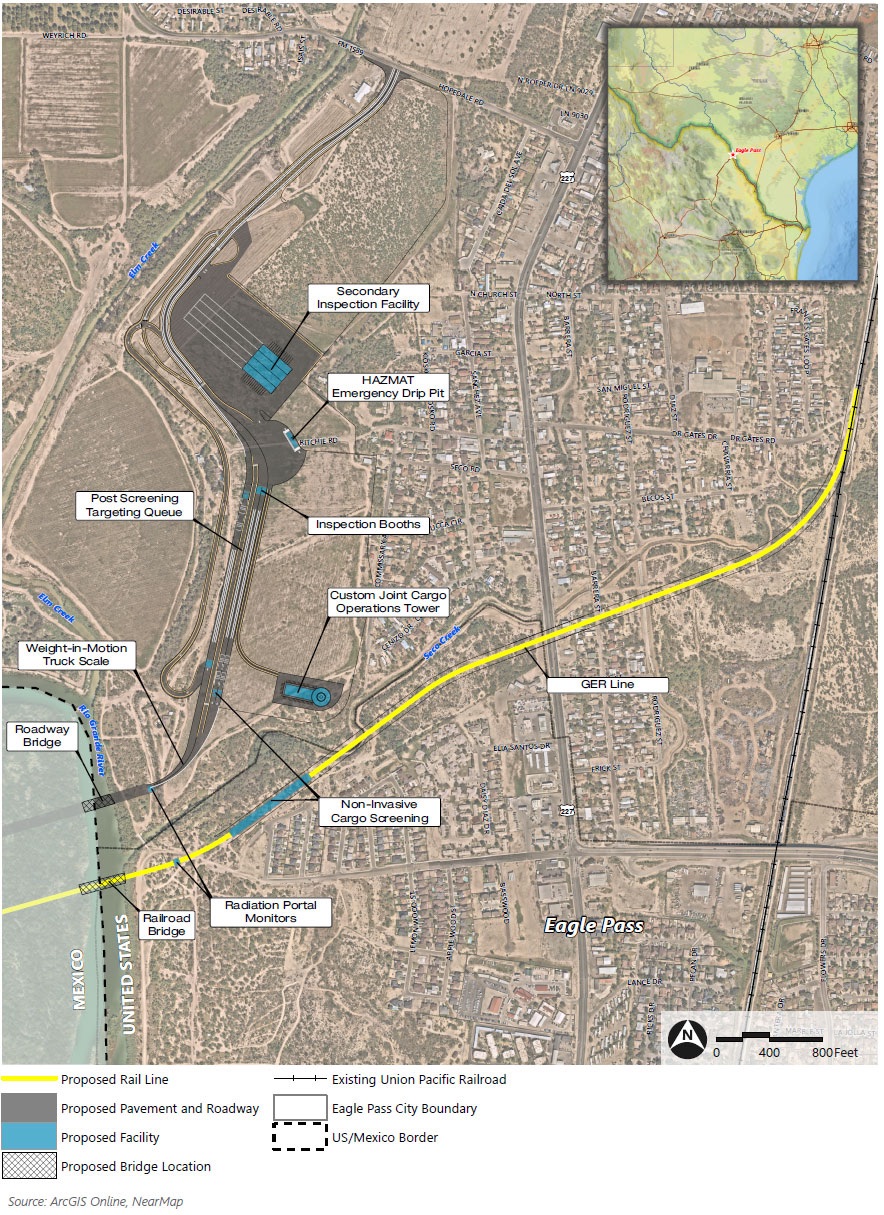April 29, 2024 Letter from Union Pacific Railroad to U. S. Surface Transportation Board Regarding Environmental Impact of Proposed Green Eagle Railroad Line and Bridge Project at Eagle Pass, Texas

By: Ricardo E. Calderon, Eagle Pass Business Journal, Inc., Copyright 2024
On the last day for the public to submit written comments to the United States Surface Transportation Board (STB) Office of Environmental Analysis (OEA) regarding the environmental impact the proposed Green Eagle Railroad Line and Bridge Project might have on the community of Eagle Pass, Maverick County, Texas, Union Pacific Railroad’s (UP) Assistant Vice-President Grant Janke for Network and Capital Planning submitted a stunning letter on April 29, 2024 detailing nine critical and strategic public scoping comments to the federal agency (STB) reviewing the Environmental Impact Statement (EIS) of this controversial project that is a part of the larger Puerto Verde Global Trade Bridge (PVGTB) project by Puerto Verde Holdings, LLC.
Union Pacific Railroad’s Janke prefaces his company’s public scoping written comments stating that “As the STB is aware, the National Environmental Policy Act (“NEPA”) requires an EIS to consider a broad range of potential effects, including ‘economic’ and ‘social’ effects. 40 C.F.R. Section 1508.1(g)(4). Thus, an EIS must include an evaluation of ‘economic and technical considerations. 40 C.F.R. Section 1502.16(a)(10). Likewise, the ‘requisite hard look mandated by NEPA’ includes evaluating any relevant “transportation issues.’ City of Riverview v. STB, 398 F. 3d 434, 443 (6th Circuit 2005). The STB’s notice of intent correctly recognizes both “transportation” and “socioeconomic” issues must be considered as part of the EIS.”
Janke adds that “Union Pacific respectfully submits there are several economic and transportation-related issues the STB should evaluate in detail as part of the EIS process in this matter.”
Janke pens that the “First,” public comment is that “the proposed railway segment could impair Union Pacific operations at its Clark’s Park yard. The distance of the proposed US/Mexico crossing to the proposed Union Pacific railway connection is only 1.3 miles. That distance does not allow for southbound trains to stage up to the border crossing without the trains impairing Union Pacific operations at Clark’s Park yard. In other words, border-staged trains in excess of 1.3 miles in length will impinge on Union Pacific’s tracks and impair yard operations. According to STB’s notice of intent to prepare an EIS, trains on the proposed rail segment would operate at an average length of 9,300 feet—well in excess of a length that could negatively impact operations at Clark’s Park yard. The STB should analyze these transportation impacts because rail operations inefficiencies in cross-border movements could lead to greater use of of truck transportation, with negative impacts on traffic congestion and emissions.”
The Union Pacific Letter continues with “Second, Union Pacific is not discontinuing the use of our current crossing or track alignment with FXE. It is, therefore, critical that Union Pacific’s direct connection to the Rio Escondido Railyard (operated by FXE) does not guarantee growth and could add costs in excess of any benefits if demand remains unchanged. STB’s EIS process should carefully consider the potential of economic waste should demand stay at current levels.”
The next comment states, “Third, the proposed project rests on an assumption GER will utilize Union Pacific (and other) locomotives. Details, however, of the full GER route have not been shared. This omission means Union Pacific cannot evaluate whether additional locomotives would be required to navigate the new route, which may trigger additional costs. In addition, the proposed grade of over 1% would be an increase from the grade present in the current route and could drive increased emissions from the locomotives GER assumes will be utilized in the proposed route.”
The following comment states, “Fourth, this proposed route would be built on above-grade structure which raises concerns about maintenance costs. STB should evaluate those cost considerations as part of its EIS analysis.”
Next, the following comment states “Fifth, the proposed project adds additional third-party complexity and cost. It would entail adding a switch or handling charge to the existing current structure, which is now a direct interchange between Union Pacific and FXE. Union Pacific has not received any information on the proposed charges or estimates to assess how these additional charges could impact the competitive attractiveness of the Eagle Pass gateway compared to other US-Mexico border gateways. The added complexity should be analyzed in the EIS.”
The Union Pacific letter adds, “Sixth, Union Pacific’s ownership interest at Clark’s Park Yard will be impacted by GER utilizing three miles of Union Pacific’s trackage for interchange. GER has also requested rights to utilize Union Pacific tracks for another ten miles north of Clark’s Park Yard for connectivity to another Class I carrier. The STB should consider the economic impact on Union Pacific’s ownership and how this proposed connectivity could hinder network fluidity. If the parties are unable to reach agreement on use of Union Pacific’s track, GER would need to construct additional infrastructure to support fluid and efficient operations. The required infrastructure would need to include not less than three miles for interchange and an additional ten miles of track to interchange farther north to another carrier, making it likely that additional trackage/mileage would be required.”
The Union Pacific letter further adds, “Seventh, GER’s proposed route is not the most direct, efficient route. Replacing the most direct route with the proposed bypass would increase the distance required to be traveled, along with associated fuel usage and emissions. The current route is 14.1 miles long; the new route will be 19.1 miles—a 36% increase in total route miles. In 2023, approximately 5,500 trains crossed the border. Adding five miles to each train that traversed the route would constitute an aggregate addition of 27,500 miles annually. These environmental impacts should be considered as part of the Board’s EIS work.”
The Union Pacific letter adds, “Eighth, adding another US-Mexico border crossing requiring additional Customs and Border Protection (“CBP”) agents to monitor a second crossing (with associated expenses) should be evaluated, particularly in inter-agency consultation with CBP.”
The Union Pacific letter adds, “Finally, while GER believes it will have better cost and operating efficiency, that contention is speculative and uncertain. GER’s proposed route is five miles longer than the current route. Moreover, GER does not have an operating plan on how it will reduce transit times. It has not yet discussed with Union Pacific the tie-in point, track counts, route and bridge design, or industrial park layout. Moreover, the parties have not discussed handoffs, customs inspections, ownership exchanges, trackage rights, cost/fees for bridge, corridor, or operations. Although it intends to operate with international crews, GER has not explained how it will establish a training and certification program for these crews. And while GER indicates that trains will be fully blocked, that blocking does not guarantee additional switching would not be required at Eagle Pass or San Antonio. Although blocked and inspected trains could improve terminal dwelling, GER has not provided any operating or transportation plans explaining how this commitment would plausibly be carried out.”
The Union Pacific letter is important because it shows that GER has not yet discussed nor reached an agreement with Union Pacific Railroad on all of the key transportation-related and socioeconomic issues raised by Union Pacific. It is obvious that GER and its parent company, Puerto Verde Holdings, LLC, are rushing to fast-track the United States and Mexico Presidential Permits instead of focusing on all significant and material environmental, transportation-related, and socio-economic issues that will impact the community of Eagle Pass, Maverick County, Texas as well as its residents, wildlife, water, air, noise, climate, and all stakeholders, including Union Pacific.





